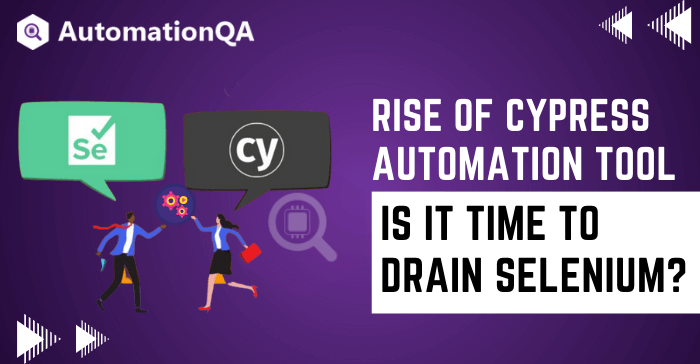
Today’s Selenium automation companies depend heavily on Selenium for Test Automation. However, Selenium comes with its limitations, such as flaky tests, slow execution speed, and difficulty in debugging. Here comes Cypress, the latest JavaScript-based testing framework, providing better test automation flexibility to software testers.
“Selenium may be old school, but Cypress is the new kid on the block.”
Indeed, Cypress can reduce testing flakiness and improve developer productivity. Its best potential lies in providing real-time feedback and faster test execution. However, the real question is – Can Cypress automation tool replace Selenium? Can it become the preferred choice for modern web application testing? Let’s find out!
Why Compare Cypress with Selenium?
Selenium and Cypress are test automation tools for functional testing on web applications. While Selenium has been widely used for many years, Cypress is a recent addition to the testing community. Despite being a newer tool, Cypress has gained significant traction over Selenium automation testing. Given its considerable growth, it’s best to compare the two before selecting the ideal test automation tool.
Key Advantages of Selenium
- Compatible with multiple operating systems
- Flexibility to use any programming language
- Support testing on modern web browsers
- Concise APIs to enable communication endpoints
Limitations of Selenium
- No built-in command for automatic test result generation
- Difficult to handle multiple web pages or element loads
- Limited support for testing images
- Challenging to create various test cases
How Can Cypress Help Selenium Automation Companies?
Cypress can eliminate many of the limitations of Selenium. For example:
- Captures snapshots during test execution
- Automatic wait commands and assertions
- Spies, stubs, and clocks for behavior control
- Automatic scrolling operation
- Supports Firefox and Edge browsers
- Excellent process documentation
Overall, Cypress offers a more streamlined and efficient approach to automated testing. Selenium consultants can use Cypress to overcome such challenges in test automation. However, Cypress does not support driving two browsers simultaneously. It offers limited support for iFrames, JavaScript, Safari, and IE. Is it the right choice to move to Cypress, then?
Selenium vs Cypress: Core Differences
| Features | Selenium | Cypress |
|---|---|---|
| Architecture | Selenium uses a client-server architecture where the test script sends commands to the Selenium server. In return, it sends a response to the browser for execution. | Cypress runs directly in the browser. It executes commands directly in the application, allowing for faster test execution. |
| API | Selenium has a more complex API with a steeper learning curve. | Cypress offers a simple and intuitive API with built-in assertions allowing easy test creation and execution. |
| Test Runner | Selenium requires the use of third-party test runners such as JUnit or TestNG. | Cypress has its test runner with a powerful GUI for running and debugging tests. |
| Supported Frameworks | Selenium supports various programming languages, and web browsers, and frameworks. | Cypress supports limited frameworks like JavaScript, Chrome, Edge, Electron, Firefox, and Mocha JS. |
Should Selenium Automation Companies Switch To Cypress?
While Cypress offers some compelling advantages over Selenium, whether or not it can replace Selenium depends on specific organizational requirements. Top Cypress consulting partners should consider the following factors:
Cross-Browser Testing
Selenium supports modern browsers like Edge, Chrome, Safari, and Firefox. Cypress, on the other hand, only supports Chrome-based browsers. If cross-browser testing is vital for your project, Selenium automation companies may aid you.
Test Scalability
Both Cypress and Selenium frameworks are scalable. Yet, Selenium’s client-server architecture supports better scalability than Cypress. It can run multiple tests on different machines simultaneously.
Conversely, Cypress is designed for running tests locally and may only be suitable for some test suites.
Community Support
Software testers have used Selenium longer than Cypress. It has a larger community than Cypress. This can be an essential consideration for finding support and resources.
Key Takeaways
Selenium and Cypress both frameworks have individual advantages and limitations. While Selenium automation companies face challenges like slow execution speed and difficulty in debugging, Cypress is limited to testing in Chrome browsers. Hence, companies should choose an automation testing framework that supports their crucial infrastructure and operational areas!
